Aristocrat tombs from Northern Wei dynasty found in Yihenaoer cemetery, Inner Mongolia
From:Chinese Archaeology NetWriter:Date:2015-04-10
Yihenaoer cemetery is situated in Yihenaoer Area, Xilin Gol League, Inner Mongolia Autonomous Region. Around them, there is typical prairie landscape where plenty of exquisite cultural relics from Northern Wei dynasty have been excavated before.In order to figure out the distribution of the tomb group, drilling and excavation of partial cemetery have been carried out by Inner Mongolia Autonomous Region’s Institute of Cultural Relics and Archaeology from August to September, 2014. 2 earthen cave-chamber tombs with a sloping passage and 1 earthen shaft tomb were discovered. Most of the tombs were spread intensively in the western part of the valley and roughly arranged in east-west rows.
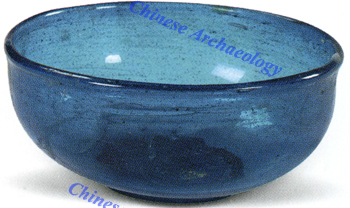
unearthed glass bowl from tomb M1 at Yihenaoer cemetery, Inner Mongolia
M4 was an earthen shaft tomb and rectangular in plane with a large opening and a small bottom. The opening of the pit was 3 m long and 1.6 m wide. The bottom of the pit was 2.6 m long, 1.18 m wide and 2.26 m high. In the center of the pit, there was a rotten and deformed wooden coffin in rectangular plane, being 2 m long, 0.75 m wide and 0.4 m high residue. Inside the coffin, there was a skeleton with straight limbs lying on the back. Lots of felt wools were discovered around the skeleton and as well on the inner walls of the coffin, which indicates that the deceased was packed in a felt when placed in the coffin. A copper belt was found in the top of the filling soil in the south of the tomb pit. 2 pottery pots and 1 tooth shell were unearthed on both sides of the tomb owner. 1 iron knife was uncovered in the vicinity of the right arm.
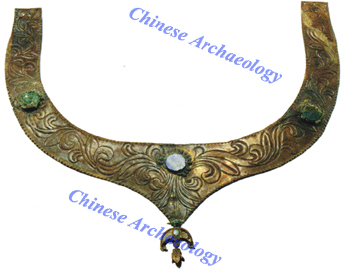
unearthed gold necklet from tomb M3 at Yihenaoer cemetery, Inner Mongolia
M5 was an earthen cave-chamber tomb with a sloping passage. Few pottery shards with comb-line patterns from Liao dynasty were discovered in the filling soil. The passage was trapezoid in plane with a relatively narrow southwest end and a relatively wide northeast end. It was 16.7 m long, 2.45-3 m wide and 8.7 m deep from the surface of the ground. The vaulted passage had straight walls and arched ceiling. It was 1.5 m long, 2 m wide and 1.5 m high residue. Various kinds of artifacts were discovered in the vicinity of the vaulted passage, including pottery pots, pottery jars, golden rings, bead decorations, copper chair nails, iron nails, feather artifacts, coffin boards, horse bones, cow bones, goat bones and etc. Tomb chamber had fallen apart. It was rectangular in plane, 3.7 m long, 3.3 m wide and 2 m high residue. The remains of the coffin were recognized from the collapsed remains in the center of the chamber,where partial painted figures were recognized, too. According to the coffin marks, we know that the coffin was heading the northeast. Its head was 2.7 m long, 1.05 m wide and 1.3 m high and its end was 0.64 m wide and 0.6 m high. Burial gifts have already been looted.
In the southwest corner of the chamber, there was a pottery pot and goat shanks. In the northwest corner, a broken lacquer work was found. A complete goat skeleton, 1 sheep shank, 2 horse right hind legs were placed on the lacquer work. Besides, a well-preserved human skeleton was discovered in the filling soil of southwest part of the passage, 2.15 m below its opening. The skeleton was lying on the back with straight limbs. Lots of felt wools were found around. 2 bronze ginkgo leaf-shaped earrings were unearthed on both sides of the skull respectively. Besides, a bronze bell was found between the femurs.
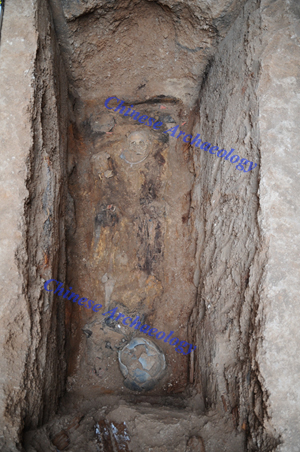
plan of tomb M6 at Yihenaoer cemetery, Inner Mongolia
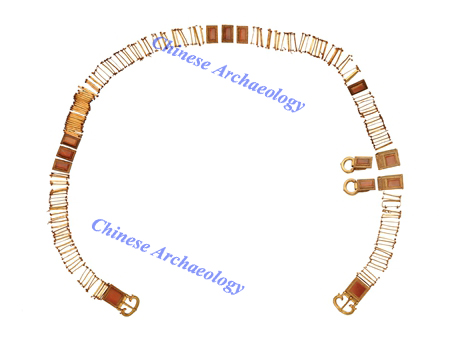
unearthed gold functional belt from tomb M6 at Yihenaoer cemetery, Inner Mongolia
M6 was an earthen cave-chamber tomb with a sloping passage which had a rectangular plane. 1 white-blue glazed porcelain bottle and few pottery shards with comb-line patterns are found in the filling soil. The slope of the passage had many shallow hollows and was about 0.6 m wide. The chamber was collapsed. In the center of the coffin, there was a human skeleton lying on the back with straight limbs. In addition, lacquer bowls and cylindrical lacquer-wares were found in the northeast of the skull. 2 golden earrings were discovered in both sides of the skull. Under the neck, there was a golden necklet. Each finger of the deceased wore a golden ring. On the waist, there was a gold functional belt. Outside the right arm, there were some wooden arrow shafts. Between the legs, a bone tool and a wooden tool had been found. What’s more, a pottery pot was placed above the feet. Under the pot, there was a bead chaining on the leather product and as well some bronze ornaments.
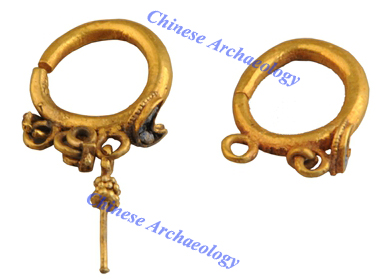
unearthed gold earrings from tomb M6 at Yihenaoer cemetery, Inner Mongolia
The pottery pot with comb-line patterns unearthed from M4 was prevalent in Liao dynasty for a long time. M5 and M6 are tombs from Pingcheng period of Northern Wei dynasty. As ginkgo leaf-shaped earrings and bronze bell found around the human skeleton in the passage of M5 were also discovered in Chenwugou tomb from Northern Wei period, Inner Mongolia, Chenwugou tomb is preliminarily predicted to be accompanying tomb of M5.
Yihenaoer tomb group is the north-most tomb group from Northern Wei dynasty discovered in China so far. According to the intensive distribution, orderly plan and relatively high rank, it obviously is an aristocratic family cemetery from Northern Wei period. On the one hand, Yihenaoer cemetery bears distinct characteristic of Xianbei culture in the aspects of cemetery structure, wooden coffin and as well pottery and etc. However, on the other hand, partial remains from the cemetery have exotic style, which implies that this group of people may either keep economic contacts with Central Asia, Western Asia and as well Eurasian Steppe through Steppe Silk Road or even migrate from those areas. The excavation of Yihenaoer tomb group provides significant materials for the researches of Steppe Silk Road, history and relations between nationalities in the frontier regions during Northern Wei period. (Translator: Ma Huanhuan)

